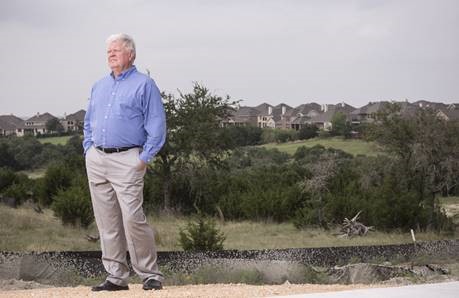“Water transfers may play a role in Texas’ water future, but as we explore in The Safety Valve, there is plenty of reason to believe they won’t solve the problem of fresh groundwater depletion on their own. Only regulation can do that, and as we see in visits to West Texas and the High Plains, our current system of local control is far from sustaining our groundwater…”

Pix Howell at Ledge Stone in Dripping Springs
“I’ve always been kind of a Don Quixote, and I saw this as an opportunity to realize that.” Pix Howell was overlooking the pool house of one of the new subdivisions sprouting up around Austin like cedar. Howell may not have developed any of the Belterras, Sweetwaters, or Bella Vitas blanketing the hillsides that once held little more than goat ranches, but he holds claim to them as much as anyone. After all, he brought the water.
Back in the 1990s, the rocky hollows of Hays and West Travis County were being plowed under and replaced with acres of 4 bedroom homes. Each new development was a taproot burrowed into the Edwards or the Trinity Aquifers, and the pumping was taking its toll. The Dripping Springs that gave its name to the seat of government in Hays County no longer dripped; even reliable wells were producing far less than they ever had.
At the time, Howell was a board member of the Lower Colorado River Authority (LCRA), which provides water to Austin and the recreation and retirement communities of the Highland Lakes. He had settled his family in Dripping Springs in the eighties. The Hill Country was the only place in Texas he wanted to live, a sentiment he knew was shared by many of the thousands flooding into the state every month, and summed up in the words of a billboard advertising one of the Hill Country subdivisions that Howell had planned: “If you’re thinking of living in Pflugerville, why’d you ever leave Lubbock?”
The only thing that stood in the way of the growth machine of the Texas Hill Country, Howell believed, was water. Opponents of growth had for years resisted the extension of new infrastructure west of Austin. The LCRA wasn’t in the business of soliciting new water customers; 90% of their revenue came from power sales, but it felt like 90% of the work went into managing the water they sold on the cheap. But Howell was convinced that the future of Hays and West Travis Counties depended on the water of the Highland Lakes, and in what he regards as a quixotic victory, he negotiated the extension of a water pipeline financed by the LCRA. “The idea,” Howell says, “was generally to furnish water necessary, if for nothing else than the growth that was already there…” Read more from Our Desired Future

